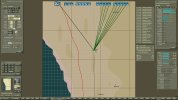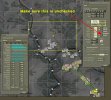The Beda Fomm scenario is a very unique situation compared to the usual Command Ops scenarios.
It represents an Army size formation withdrawing down a very long road, short on supplies with poor quality troops and equipment.
The whole of the Italian Army needs to move down this road to exit at the other end or to stay in contact with the exiting force, as they are being chased by the British.
The SEP where the units enter the map on day one, has dwindling supplies, as more and more troops are withdrawn from the area north of the map and by day three it is of no further use.
The Bases that in most scenarios are usually deployed near the SEP, and can remain there for the entirety of the scenario, in this scenario need to move long distances down the road in order to withdraw from the peninsula and stay within contact of their formations.
This is actually an excellently designed scenario in my opinion, but is let down by the Command Ops 2 game engine supply mechanics.
This scenario really pushes the games supply mechanics to the limit, and I'm sad to say that it has thrown up quite a few problems.
I have been back on my test scenario to try and isolate the problem with the Bases freezing up.
The below image shows one of the bases that has been given a move order to move to the bottom of the map. The order given is displayed top left of screen.
The other units on the map have been given a defend in situ order and fuel set to min supply.
I had to put other units on the map or the base is not allocated any supply at all for its depot.
The information on the right is the current state of the Base selected.
It stopped quite early on in the scenario to refuel when its fuel supply was reading 59 liters remaining.
It then moved a short distance after many hours of just sitting there, then ran out of fuel completely.
Since then it has been putting out multiple requests for fuel, that are ignored by its superior base.
As you can see the Base has plenty of fuel in its own stores, so it is still trying to draw from the base above it in the supply chain.



